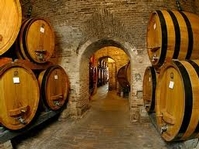Andrea Contucci lives in a home his great-great-grandfather’s great-great-grandfather thought was old. Amazingly, he also makes wine in the same cellar beneath it.
Contucci runs the last winery in the city of Montepulciano, and it’s right in the town square. It was built in the 1530s in the way landowners lived then, with living quarters on top and a winery down below. There’s a  below-ground-level door for barrel delivery that opens upward onto the piazza. Contucci can hear people chatting in cafes while he works.
below-ground-level door for barrel delivery that opens upward onto the piazza. Contucci can hear people chatting in cafes while he works.
I had some interesting conversations in Montepulciano about New World vs. Old World winemaking techniques, particularly with Federico Carletti, who runs Poliziano winery and is chairman of the Consorzio del Vino Nobile di Montepulciano. Carletti talked of how much has changed in the region: No more white grapes in the red wines, for example, as well as the technical and viticultural advances that have occurred all over Italy.
"You can say what we make now is the modern style. But it’s better," Carletti said. And overall he’s probably right; we romanticize the wines of the ’60s, but the truth is plenty of them had hygiene problems and plenty more were over-cropped and under-cared for.
But then, I visited Contucci, which is a breathtaking experience probably better described by an architecture critic.
We met in a courtyard on the main floor; windows of Andrea Contucci’s relatives, surrounding the courtyard, were closed. We walked upstairs to a room with an amazing ceiling about which a reporter based in Rome started raving, "That looks like the ceiling of the Continente Grand Hotel in Siena!" Contucci said, "This is the original." Turns out it was painted for the wedding of a Contucci and an Avignonesi, who have been big names in the wine industry for centuries. The first document that mentions Contucci wines was in the year 1008.
Another reporter whispered about the decor, "It looks like a museum." Again, Contucci brought us around: "It’s not a museum," he said. "We make the wine in the cellar." I’m glad I’ve asked to see it, because I’ve seen a lot of wine cellars, but not many that haven’t changed in 500 years.
No stainless steel here: Contucci ferments in 1600-litre barrels of French and Slovenian oak that seem to fill the room. "We have small barrels that we use to make tests," Contucci says. "We don’t like the wine. Well, we like the wine but it’s not Vino Nobile di Montepulciano. We don’t want to make California wine or other Tuscan wine. We want to make Vino Nobile di Montepulciano."
And in fact, Contucci hasn’t added second labels or expanded past 100,000 bottles a year because, even though the family owns 420 acres in the countryside and has a "small building," Andrea Contucci believes, "If we move to the countryside, we are like everyone else."
I suggested that perhaps the flavors he prizes come from native yeasts that take residence in the building. In Japan, old sake companies sometimes experience a change in taste when they move because the dominant yeast changes.
Contucci doesn’t like my yeast theory. At first he talks of terroir: "The right earth, the right grapes, the right people." But he does believe the building contributes more. "Here, you see, there is nothing electric. The temperature is natural. There is no concrete. There is no electrostatic energy here. Here the wine is completely relaxed. You cannot do that in a new winery."
Contucci uses the four traditional red grapes of the region, though 80% are Sangiovese. Many wineries in Italy now blend with Merlot because Italian Merlot, unlike what you may have tried from California, is pretty awesome, giving richer body and softer mouthfeel and yet still tasting plenty fresh. But Contucci thinks his wine is gentle enough. "We don’t blend with Merlot because when you blend Sangiovese with Merlot, it is another wine," he says.
Contucci makes five wines: A main yellow-label Vino Nobile, two single-vineyard wines, a Riserva, and a cheaper Rosso di Montepulciano. I liked them all, but I really loved the two single-vineyard wines, which are very different, as they should be. The ’08 wine from Pietra Rosso vineyard is much fruitier, while the ’08 Mulinvecchio vineyard wine, my favorite of all the Vino Nobiles I tried, is earthy, spicy, and even cedary while still being fresh and delivering plenty of fruit. This is as good as Vino Nobile di Montepulciano gets, and it’s amazing to think it of it fermenting by candlelight beneath the town square.
I asked Andrea Contucci, while finishing off my glass in one underground room that does have an electric light, if he felt the weight of history: The pressure of growing up in museum-like home, upholding the family name. This is not a minor threat. The last scion of Germany’s oldest estate, Schloss Vollrads, shot himself in the head while overlooking the vineyards in 1997 because he had fallen into debt.
Asking the question is how I learned what is now my favorite expression in Italian.
"It is not a pressure do this," Contucci says. "It is the life I have. I was born into this house, this city. I have no pressure. I live lightly. I like to be spontaneous."
The phrase is "vivre con leggerezza" (pronounced "lejjerezza"), and it best translates as "live with lightness." You could worry about another hot, dry summer that sunburns the grapes, or the football scores, or how many Facebook likes you have. Or you could live the good life of the 16th century, with lightness.
